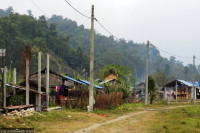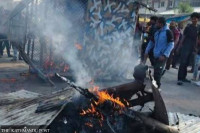National
Over 400,000 single women and disabled people deprived of social security allowance ahead of Dashain
An amendment bill to the Social Security Act to ensure benefits to the deprived groups has yet to be passed by Parliament.
Prithvi Man Shrestha
There is an uncertainty over when single women below 60 years of age and severely disabled people will get social security allowance, as an amendment bill to the social security law is yet to be endorsed by Parliament.
The government had registered the amendment proposal to the Social Security Act 2018 to ensure state allowance to single women and disabled people who were deprived of the benefits under a new regulation introduced in March.
Under the regulation, single women below 60 years of age and people with partial disability were no longer entitled to the social security allowance.
The amendment proposal was registered in Parliament following widespread criticism and protests against the regulation that has affected over 400,000 single women and disabled people.
“As the amendment bill was not passed through the budget session of Parliament, there is an uncertainty over when single women below 60 years and people with partial disability will be able to get the social security allowance,” said Jitendra Basnet, director general at Department of National ID and Civil Registration.
The government usually distributes the social security allowance before the Dashain festival. With the festival just a couple of weeks away, there is little chance of single women below 60 years and partially disabled people getting the allowance.
Although the government had provided them with financial assistance, the support was discontinued after mid-July, as the amendment bill was registered in Parliament.
“They may not get the social security allowance until the amendment bill becomes a law,” said Basnet. “The government, however, has the option of continuing the financial assistance to the groups who have been deprived of the state benefits.”
According to the Department of National ID and Civil Registration, there are around 350,000 single women below 60 years and over 80,000 people living with partial disability.
“Our demand is that the government introduce an ordinance to start the distribution of the social security allowance to the concerned groups,” said Raju Basnet, general secretary of the National Federation of Disabled-Nepal.
As per the section 7 of the Social Security Act, only single women aged above 60 years are eligible to get the allowance. In order to become eligible for social security allowance, single women under 60 years need to prove that they have no source of income or have fixed income below the threshold determined by the government.
The government has been providing benefits to single women above the age of 60 since 1994. Single women under 60 years were also included in the social security allowance programme in 2009 following the Supreme Court’s ruling that ordered the government not to discriminate single women based on their age.
Likewise, section 8 of the current law states that the people with total disability shall get disability allowance in a sum specified by the government as the social security allowance.
“Social security allowance is the fundamental rights of the disabled people as per the article 22 of the constitution,” said Basnet, the general secretary of the National Federation of Disabled-Nepal. “The current social security law is against the constitution.”
According to him, the current law also denies the allowance to the visually impared, people with hearing problems, and people who have to spend their lives in wheelchairs.
“Many many disabled people are completely dependent on the social security allowance for survival,” Basnet said.
While introducing the law, the government had argued that its decision was aimed at curtailing the growing spending on social security. During the period between 2012 and 2016, Nepal’s spending in social protection stood at 1.7 percent of its Gross Domestic Product (GDP), which is higher than the average one percent of GDP in South Asia and the global average of 1.6 percent, according to the World Bank.
During this period, Nepal spent just 1.17 percent of its GDP in the health sector.
In the last fiscal year 2018-19, the government spent 3.8 percent of its total expenditure in social security against 3.25 percent in health and 3.26 percent in education.




 8.12°C Kathmandu
8.12°C Kathmandu













%20(1).jpg&w=300&height=200)

